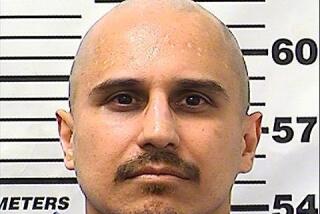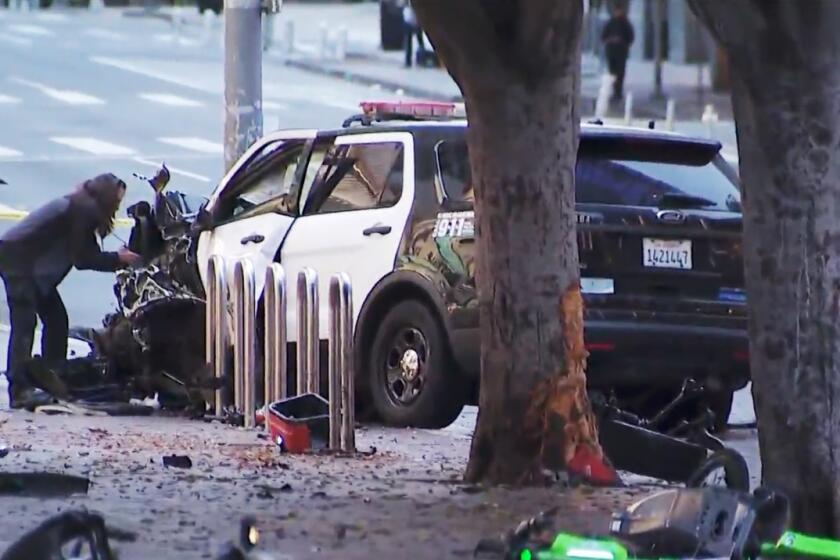EPA to Target Polluters for Ground-Water Cleanup Cost
The U.S. Environmental Protection Agency, which has come under attack for delays in cleaning up San Gabriel Valley ground water, announced at a congressional subcommittee hearing in Baldwin Park this week a strategy to force polluters to pay for the cleanup. But an agency official conceded that the new plan may not work.
The problem, an EPA official said, is that thousands of companies stored and used the kinds of chemicals that have leaked into ground water, and locating the firms responsible for the contamination will not be easy. Also, some of the contamination could have occurred as long ago as the 1940s, and the companies responsible may no longer exist.
Jeffrey Zelikson, director of hazardous waste management in EPA’s Western region, said his agency will seek funds from polluters to pay for a system to treat polluted ground water in Azusa and Baldwin Park. He said the EPA has already talked to the Department of Justice about taking legal action to compel companies to pay for the cleanup effort.
But, he said, establishing responsibility is going to be difficult, and his regional office is seeking additional funds from Washington to help pay for the investigative work.
He said he is also concerned that the burden of paying for the cleanup could drive small businesses into bankruptcy. The cost of the cleanup has been estimated at hundreds of millions of dollars.
The contaminants include trichloroethylene and perchloroethylene, compounds that have been used for years as cleaning solvents by industrial plants, dry cleaners, machine shops and other businesses.
Rep. George Brown (D-San Bernardino) suggested at the hearing, conducted by the House small business subcommittee on environment and labor, that the search for polluters may turn out to be futile and a waste of money. Brown noted that under the federal Superfund law that is providing money to remove pollutants, the EPA is obligated to try to recover its expenses from the companies that caused the environmental damage. But, Brown suggested, that approach may not work in this case.
He told Zelikson: “If you have an impossible task, you should tell us.”
Zelikson said it may turn out that the San Gabriel Valley ground-water problem cannot be handled the way the EPA handles other Superfund sites, which usually consist of a small toxic area with a limited number of polluters.
In the San Gabriel Valley, the contamination has affected 20% of a 200-square-mile underground water basin, and pollutants have been found as far as 700 feet below the surface. The Los Angeles Regional Water Quality Control Board reported this week that the contamination has invaded 245 of the area’s 400 wells. Sixty-five of the wells, considered the most contaminated, have been closed.
Zelikson said the EPA wants to move against suspected polluters as quickly as possible so that it can determine whether it can count on cleanup funds.
“We need to test if we have a futile situation on our hands,” he said.
If polluters cannot be identified and compelled to pay, local water officials have said the massive job of controlling ground-water contamination could be delayed, or San Gabriel Valley residents and businesses could be asked to shoulder part of the cost through higher water bills or taxes.
In written testimony submitted to the subcommittee, C. David Willis, deputy director of the state’s toxics program, said that recovering costs from polluters is unlikely and that officials should begin considering other ways of paying for the cleanup.
‘New Approach Needed’
“It is apparent that a new approach based on new funding sources and local, state and EPA cooperation will be needed to solve the contamination problems in the San Gabriel Valley,” Willis said.
But Assemblywoman Sally Tanner (D-Baldwin Park), who also submitted written testimony to the subcommittee but was unable to appear, said she will insist that the cost not be transferred to San Gabriel Valley residents who are not responsible for the problem.
“I don’t feel that the residents of the San Gabriel Valley should have to bear the brunt of these costs through increased water rates,” she said.
“From my first involvement in this issue,” she added, “I have always contended that local residents should not have to pay the price of contamination, which I feel is a result of sloppy storage, use and disposal practices of hundreds of businesses that have come and gone in the valley through several decades.”
Opposes Delay
Rep. Esteban Torres (D-La Puente), who conducted the hearing as chairman of the congressional subcommittee, said he hopes that the EPA will be able to find polluters and make them pay, but he added that the agency should not delay projects while waiting to collect money from private companies.
“I think they ought to clean up (the ground water) and then go after the polluters,” Torres said.
Zelikson said the EPA’s next step will be to release a report next month that will outline its strategy for cleaning up pollution in the San Gabriel Valley. Top priority, he said, will be given to the proposed project to treat ground water in Azusa and Baldwin Park.
Zelikson said the EPA has committed up to $100 million to the San Gabriel Valley and has spent $8.5 million so far.
The funding commitments include $1.5 million to design and build a treatment system to serve 217 customers of the Richwood Mutual Water Co. in El Monte, $5.5 million for a treatment system for 17,000 customers of Suburban Water Systems in Whittier and $10 million to $40 million to stop the movement of pollutants from the Main San Gabriel Basin, which underlies the San Gabriel Valley, south through Whittier Narrows into the Central Basin.
The EPA came under fire at the hearing for its expenditures on Richwood and Whittier Narrows.
Still Not Operational
Torres asked why the EPA spent $1.5 million and took six years to build a treatment system for Richwood that is still not operational, while the owners of another small water company in El Monte, Hemlock Mutual, solved a similar pollution problem on their own much more quickly for $40,000.
Zelikson said Hemlock’s system does not meet EPA design standards, but conceded that EPA’s “complex and somewhat bureaucratic” procedures inflated the Richwood costs. “We’re learning as we go along,” he said. “We can probably build a system today for less than we spent on Richwood.”
Robert G. Berlien, general manager of the Upper San Gabriel Valley Municipal Water District, complained that the emphasis on work at Whittier Narrows does nothing to improve the water supply of the San Gabriel Valley, whose wells lay upstream. He said more attention should be paid to Azusa and Baldwin Park, which have the heaviest contamination.
But Zelikson said: “There is no question that implementation of the Whittier Narrows containment is absolutely the right thing to do.”
He said it is essential to stop contaminants from seeping into the Central Basin, which, like the Main San Gabriel Basin, serves 1 million people.
Lack of Information
Much of the criticism directed at EPA focused on the slow pace of the cleanup effort and the lack of information about what EPA is doing.
Berlien said that although the pollution problem was discovered nearly a decade ago and has been on the EPA priority list for five years, no water has been cleaned up and there is no comprehensive plan. “Water suppliers do not have a clear understanding of where the cleanup project is headed,” he said.
Wilfred R. Baca, representing the Hacienda Heights Home Improvement Assn., said he has tried without success to find out what procedures EPA is using to develop legal cases against polluters. He said his efforts to obtain information have been rebuffed by EPA with the assertion that disclosure could jeopardize the success of the agency’s investigations.
But unless the EPA will say what it is doing, Baca said, outsiders have no way of measuring its performance.
Baca said it seems incredible to him that the EPA has been working on the San Gabriel Valley project for years without developing an overall plan.
There should be no mystery about what to do, Baca said. “We need to start pumping out water and cleaning it up.”
More to Read
Start your day right
Sign up for Essential California for news, features and recommendations from the L.A. Times and beyond in your inbox six days a week.
You may occasionally receive promotional content from the Los Angeles Times.






